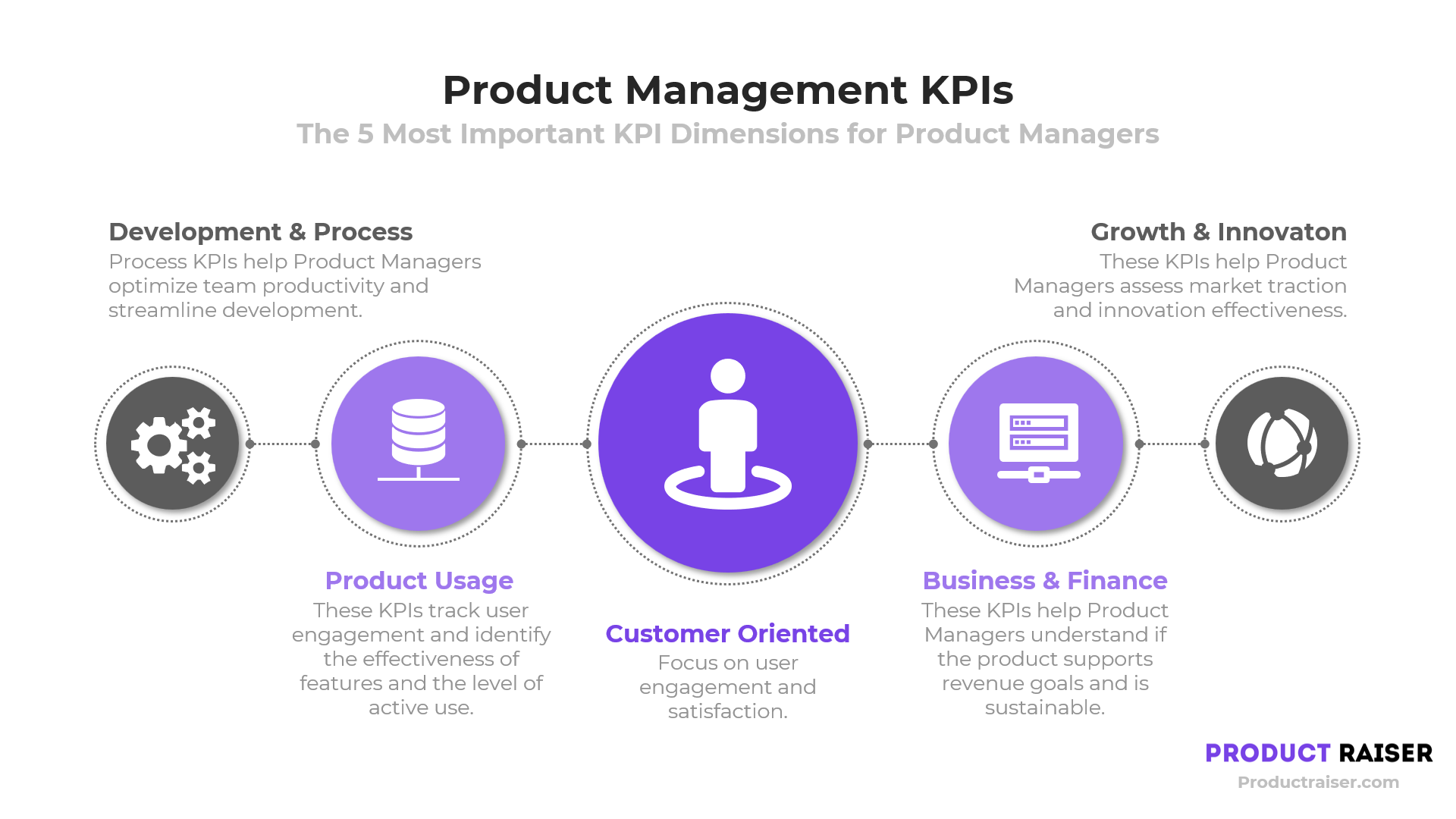Home
The 16 most important Product Management KPIs and how to track them
Master essential Product Management KPIs to boost growth, user satisfaction, and team efficiency with data-driven insights & strategies.
CHRISTIAN CASSISI – 11/08/2024

Person is analyzing Product Management KPIs / Pexels.com / Lukas
In product management, Key Performance Indicators (KPIs) are metrics that help Product Managers gauge the health of their products in areas like customer engagement, market growth, and profitability. Understanding how to interpret KPIs is essential for Product Managers to make data-driven decisions that enhance product performance and user satisfaction. Below, we explore the essential KPIs every Product Manager should monitor, how to calculate them, and what changes in these numbers typically mean.
Why Product Management KPIs Matter
KPIs provide objective insights into a product’s performance, helping Product Managers assess how well the product aligns with business goals and user needs. These indicators clarify areas of success, highlight potential risks, and guide strategy. Let’s dive into the KPIs across key areas, including formulas for each and explanations for interpreting their changes.

Customer-Oriented KPIs for Product Management
These KPIs focus on user engagement and satisfaction, helping Product Managers gauge how well the product resonates with customers.
Net Promoter Score (NPS)
NPS measures customer loyalty by asking how likely customers are to recommend the product. Scores group customers into promoters, passives, and detractors.
Increase: A rising NPS indicates stronger customer loyalty and satisfaction, often due to an improved user experience or product value.
Decrease: A declining NPS suggests dissatisfaction, which may require adjustments in customer support, product features, or usability improvements.
NPS is a powerful way to gauge user loyalty and get a feel for overall customer happiness.
Customer Retention Rate
Customer retention tracks the percentage of users who remain engaged with the product over a set period.
Increase: Higher retention means the product continues to meet users’ needs, encouraging long-term loyalty.
Decrease: A drop may signal customer dissatisfaction, increased competition, or a need to revisit user engagement strategies.
Retention is closely related to churn rate. Next, let’s look at churn, which measures the customers you lose over time.
Customer Churn Rate
Churn rate shows the percentage of customers who stop using the product in a given timeframe.
Increase: A higher churn rate is a warning sign, indicating issues like poor user experience or insufficient value, which should be addressed promptly.
Decrease: A lower churn rate means users are finding long-term value, signaling healthy product engagement.
Churn is an important counter to retention rate. Tracking both KPIs gives a full picture of customer loyalty.
Customer Satisfaction Score (CSAT)
CSAT is often measured through user surveys, asking customers to rate their satisfaction with the product.
Increase: Rising CSAT reflects improvements in customer experience and satisfaction.
Decrease: Declining CSAT could mean that aspects of the product or service aren’t meeting expectations, warranting a review of customer feedback.
CSAT is great for understanding specific experiences. Next, let’s shift from customer experience to how users engage with your product daily
2. Product Usage KPIs for Product Managers
These KPIs track user engagement, helping Product Managers identify the effectiveness of features and the level of active use.
Monthly Active Users (MAU) and Daily Active Users (DAU)
MAU and DAU show the number of unique users who interact with the product over a given period
Increase: A high DAU/MAU ratio (often 20%+ is ideal) indicates frequent user engagement and strong product stickiness.
Decrease: A drop in this ratio suggests users may not find enough value to return regularly, highlighting a potential need to improve engagement features.
Next up is feature adoption, a KPI that measures how well specific features are being used.
Feature Adoption Rate
Feature adoption measures how many users engage with a specific feature, showing its relevancy and usefulness.
Increase: Rising feature adoption indicates the feature resonates with users, validating its development and marketing efforts.
Decrease: Low adoption might mean the feature isn’t relevant to users or requires better communication or onboarding.
Let’s move to session duration, which tracks how long users stay engaged during a single session.
Session Duration
Session duration tracks the average time users spend on the product, offering insights into engagement quality.
Increase: Longer session durations often mean users find the product engaging and valuable.
Decrease: A decrease could suggest user friction or a lack of engaging content, signaling an opportunity to refine the user experience.
After usage, let’s look at KPIs that track the business and financial health of your product.
Business and Financial Product Management KPIs
Business KPIs track the financial impact of the product. These KPIs help Product Managers understand if the product supports revenue goals and is sustainable. Let’s look at some essential financial metrics.
Customer Lifetime Value (CLTV)
CLTV estimates how much revenue a customer brings over their relationship with the product. Knowing CLTV helps Product Managers plan for growth and set marketing budgets.
If CLTV increases: Higher CLTV is a good sign. It means customers are bringing more value over time and staying engaged longer.
If CLTV decreases: Lower CLTV suggests that customers aren’t staying long enough or spending enough. This might mean you need to focus on customer satisfaction or retention strategies.
CLTV is closely related to CAC. Up next, let’s look at CAC, which tells you the cost of acquiring each new customer.
Customer Acquisition Cost (CAC)
CAC shows the cost of acquiring a new customer, which is essential for evaluating marketing efficiency.
If CAC increases: Higher CAC means it’s costing more to get new customers. It could be a sign to optimize marketing or focus on retaining existing customers.
If CAC decreases: Lower CAC is a positive sign. It means you’re getting customers at a lower cost, which supports profitability.
Next is revenue growth rate, which shows how well the product is doing financially.
Revenue Growth Rate
Revenue growth rate tracks how much revenue changes over time. It’s a key indicator of financial performance.
If revenue growth rate increases: Rising revenue shows that demand for the product is growing and financial strategies are effective.
If revenue growth rate decreases: Lower growth can mean market saturation or competition is affecting sales, suggesting a review of sales and marketing efforts.
Let’s move on to gross margin, which measures profitability.
Gross Margin
Gross margin shows the product’s profitability by calculating the revenue left after costs.
If gross margin increases: Higher gross margins mean the product is profitable and costs are managed well.
If gross margin decreases: Lower margins may indicate rising costs or pricing issues, suggesting a need to review expenses.
Next, we’ll look at development KPIs that track team productivity.
Development and Process KPIs in Product Management
Process KPIs help Product Managers optimize team productivity and streamline development.
Cycle Time
Cycle time tracks the time required to complete a task or feature.
Increase: Longer cycle times indicate potential bottlenecks, possibly slowing down the product’s responsiveness to market needs.
Decrease: Shorter cycle times mean faster iterations, allowing the team to release updates more efficiently.
Velocity
Velocity measures the amount of work completed in a set period, often within Agile sprints.
Increase: Higher velocity suggests efficient workflow and team productivity.
Decrease: A decrease may indicate resource constraints or process inefficiencies, signaling the need for process adjustments.
Defect Rate
Defect rate measures the number of issues or bugs identified in each release.
Increase: A higher defect rate indicates quality control issues, which could affect user satisfaction.
Decrease: Lower defect rates show improved product quality and more rigorous testing processes.
Burn Rate
Burn rate tracks how quickly the team uses its budget, helping with financial management.
Increase: High burn rates can lead to budget overruns, indicating the need for tighter financial control.
Decrease: Lower burn rates show efficient resource use, allowing for budget reallocation or savings.
Growth and Innovation KPIs in Product Management
These KPIs help Product Managers assess market traction and innovation effectiveness.
Monthly Recurring Revenue (MRR) or Annual Recurring Revenue (ARR)
MRR or ARR shows predictable revenue over time, especially relevant for subscription-based products.
Increase: Growth in MRR/ARR suggests successful retention and user demand.
Decrease: Decline in MRR/ARR may indicate issues with retention or acquisition, prompting a review of user value propositions.
Feature Usage Growth
This KPI tracks the growth in usage of specific features, helping identify successful innovations.
Increase: Rising usage growth indicates that new features resonate with users, validating development efforts.
Decrease: A decline may mean users don’t find value in certain features, requiring further analysis.
Experiment Success Rate
This measures the percentage of successful experiments, guiding prioritization of future initiatives.
Increase: High success rates indicate effective experimentation, helping drive innovation and growth.
Decrease: A low success rate may suggest the need for refined experimentation processes or better alignment with user needs.
We can really recommend this video. It provides really good overview about Product Management KPIs for Product Managers.
Common Challenges and Mistakes in Product Management KPI Tracking
While KPIs are powerful tools, there are common pitfalls to avoid in KPI tracking and interpretation. Here are some of the most frequent challenges and errors:
1. Over-Reliance on Numbers
Quantitative data is invaluable, but relying solely on numbers can create a limited view. Balance KPIs with qualitative data—like user feedback and interviews—to gain a more complete understanding of your product’s performance.
2. Ignoring Qualitative Data
Quantitative KPIs can show what’s happening, but qualitative insights tell you why it’s happening. Product Managers should integrate user feedback and qualitative research to complement KPIs and better understand customer needs and pain points.
3. Unrealistic Goals and KPI Overload
Setting overly ambitious targets can lead to disappointment or stress for the team. Similarly, tracking too many KPIs at once can make it difficult to stay focused. It’s best to prioritize KPIs that align with the most critical product objectives.
Each of these mistakes can distort how you interpret your KPIs, making it harder to make effective decisions. Recognizing these challenges early on helps Product Managers avoid common pitfalls and focus on meaningful metrics.
Tools and Software for KPI Tracking
Choosing the right tools can simplify KPI tracking, data visualization, and reporting. Many KPI tracking tools are designed to provide real-time data and customizable dashboards, making it easier for Product Managers to stay informed. Here are some top tools for KPI tracking:
Atlassian: Offers tools like Jira for project management and tracking development KPIs, making it ideal for Agile teams.
ClickUp: A versatile platform with robust tracking, reporting, and dashboard capabilities that can integrate with other tools for a centralized view of metrics.
Google Analytics: For customer and usage KPIs, this tool provides detailed insights into user behavior, engagement, and growth metrics.
Tableau and Power BI: Advanced data visualization tools that help Product Managers create in-depth, interactive KPI dashboards.
These tools can support a KPI dashboard approach, offering an organized view of your key metrics in one place.
Your next Step with Product Management KPIs
Effective Product Management KPI tracking is about finding the balance between numbers and context. By using the right tools, setting up clear dashboards, and involving the team in the analysis, Product Managers can create a data-informed culture that drives smarter decisions. Regular review and adaptation keep KPIs relevant and help guide the product toward continuous improvement.
Ready to work with Product Management KPIs? Subscribe to our newsletter for templates, expert tips, and the latest tools to help you get started!
Newsletter
MORE TIPS, TEMPLATES AND EXCLUSIVE INSIGHTS
Stay Ahead Of Others With Our Newest Articles
Best Product Ideation Frameworks and Processes
Learn key steps, agile techniques, and frameworks to master product ideation with real-life examples and best practices!
10 Essential Product Market Fit Survey Questions
Discover essential survey questions to understand customer pain points and validate product-market fit for your product.
Feature Adoption Rate | Benchmark & Case Studies
Discover what a good feature adoption rate is, how to measure it, and benchmarks to target. Learn the formula and examples from top companies.
Enhance A/B Testing Accuracy with Re-Randomization for Product Management
Boost A/B test accuracy in product management with re-randomization., Reduce bias, and gain reliable insights for data-driven decisions.
16 Key Activities to Validate Product-Market Fit During MVP-Phase
Discover key activities to validate product-market fit during MVP. Learn hands-on strategies to refine your product, meet user needs, and drive growth.
Top 10 Best Product Management Books for PMs
Learn how to optimize listings, gain reviews, and boost sales on Amazon in 2024.






